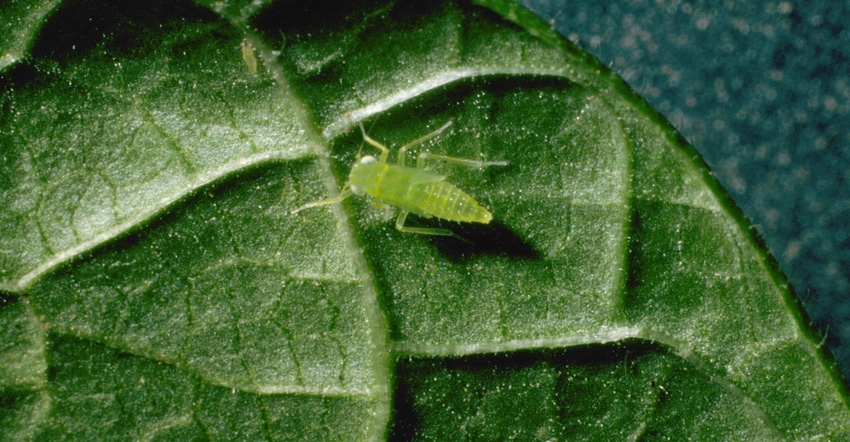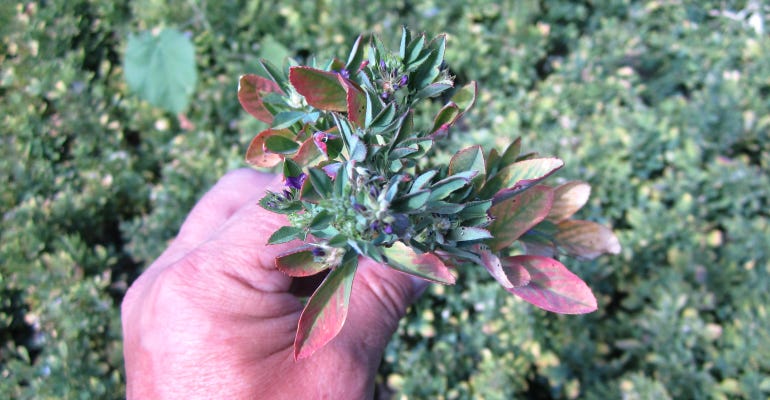
Now is the time to be on the lookout for potato leafhopper in alfalfa.
These nasty critters are the most damaging pests to alfalfa in Pennsylvania, but they can also damage legume forages and even some vegetables.
“Potato leafhopper is most challenging during June and into July. The species can be quite spotty, so applying insecticides blindly, without knowledge of their populations, is unlikely to be useful,” says John Tooker, assistant professor of entomology at Penn State. “Many growers apply insecticide every cutting, but our research at Penn State has shown that this is not necessary.”
So, how can you track the population of potato leafhopper to better control them? Sweep for them.
“The best way to manage it is to scout with a sweep net and compare the number found per sweep (averaged over at least 10 sweeps) to the economic threshold, which is based upon the height of the alfalfa, the cost of the insecticide and value of the hay,” he says.
You can see the table online. You can also find information on making a homemade sweep net, which can be assembled using materials commonly found on farms.
Insect nets can be bought in a store, but it must be at least 15 inches in diameter with a tightly knit bag, such as muslin.
So, how and when should you sweep for leafhoppers? Here are five tips from Penn State Extension to sweeping and counting potato leafhopper:
1. Sample at 2 to 3 inches high. If you’re late with spring seedings, start sampling when the plants are 3 inches high. Resample at weekly intervals until the field is sprayed, or until 10 days before harvest.
For new summer seedings, start sampling when the plants are 2 inches high and resample at weekly intervals until mid-September.
For all second and third cuttings, sample when plant regrowth is 2 to 3 inches high. Resample at weekly intervals until the field is sprayed, or until 10 days prior to harvest. A yardstick can measure the plant height.
2. Follow the ‘I’ or ‘U’ pattern when sampling. In square or rectangular fields, follow a "U" pattern. In narrow strips, an "I" pattern will work best.
Sample five sites each.
You can sample fields any time of day when the alfalfa is dry. Avoid sampling in cold or windy weather, or when the alfalfa is wet.
3. Make 20 sweeps at each site. Make 20 pendulum sweeps with the net at each site, sweeping 3 to 4 inches below the tops of the plants. Don't stop swinging until you complete 20 sweeps.
When you complete 20 sweeps, continue swinging the net several times to force the insects into the small end of the bag. Quickly grab the bag about 10 inches from the small end to trap the insects.
4. Only count green leafhoppers. Count and identify the potato leafhoppers collected. Only count the pale green leafhoppers — nymphs are yellowish green — and disregard any brown ones.
 DAMAGE DONE: Once damage is done by potato leafhopper, early harvest or insecticide application are the only two options available.
DAMAGE DONE: Once damage is done by potato leafhopper, early harvest or insecticide application are the only two options available.

Be careful when opening the net; adult leafhoppers are very active and can easily escape without being noticed. Unfold the net slowly and let the insects escape a few at a time, counting them as they appear. Be careful to check the interior walls of the net for nymphs. They cannot fly and will be walking or clinging to the cloth.
It may be easier for you to kill the insects before counting them.
5. Calculate average leafhoppers per sweep. Make a note of the total number of leafhoppers and repeat the same procedure at the next four sites, which completes your 100 sweeps of the field.
You can then calculate the average number of leafhoppers per sweep. For example, if you collected a total of 60 leafhoppers, find the average per sweep by dividing 60 by 100, which equals 0.6 leafhopper. When the leafhopper population is high (40 or more in 20 sweeps) at the first site, spending time sampling the other four sites is of little value.
Tooker says that a good integrated pest management program is the best method for long-term control of potato leafhopper, along with planting resistant alfalfa varieties.
“Using IPM allows natural enemy populations to build in alfalfa fields, and the natural enemies, particularly spiders, can really help keep potato leafhopper populations in check, but spraying insecticide unnecessarily will set natural enemy populations back,” he says. “Resistant varieties are available. All the resistant varieties that I know of have glandular trichomes that help suppress leafhopper feeding.
"In our experience, resistant alfalfa can help delay the onset of hopper burn and limit the need for insecticides to one application per year. Yield potential of resistant alfalfa appears to be much better than it once was, and we find it competitive with nonresistant varieties.”
About the Author(s)
You May Also Like






